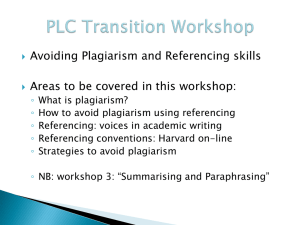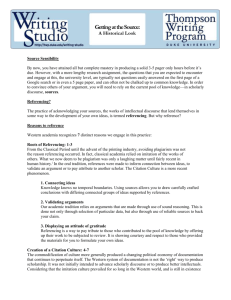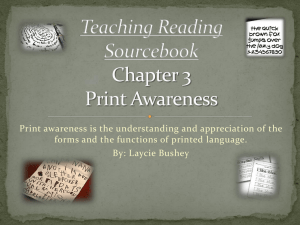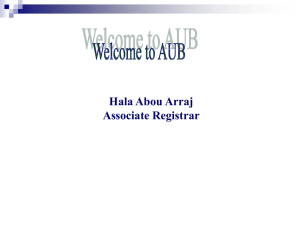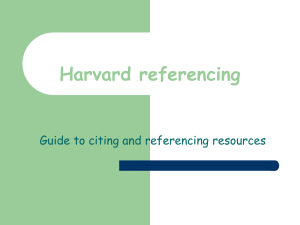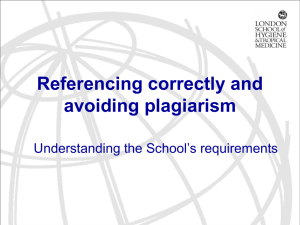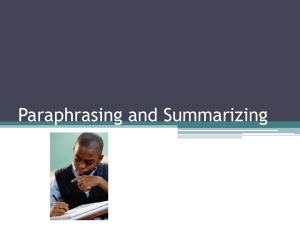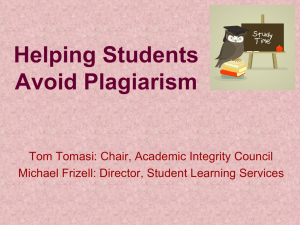What is plagiarism? - University of Adelaide
advertisement
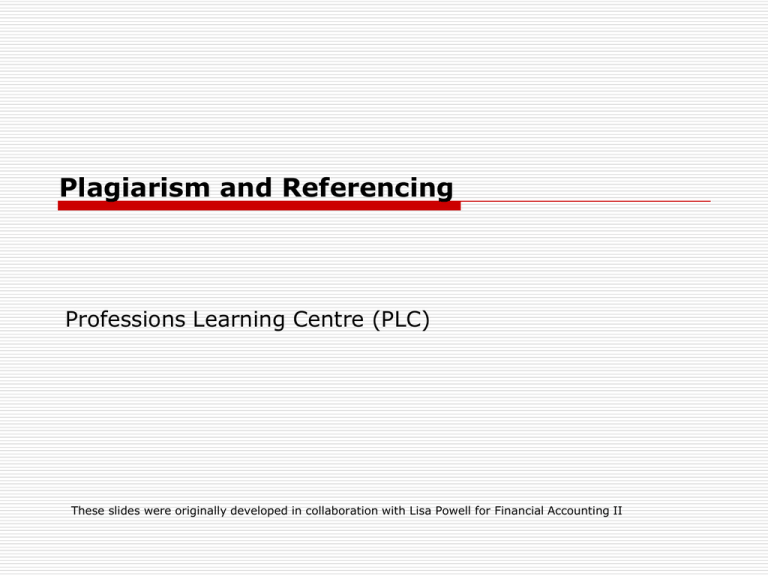
Plagiarism and Referencing Professions Learning Centre (PLC) These slides were originally developed in collaboration with Lisa Powell for Financial Accounting II What is plagiarism? One definition: ‘Plagiarism is passing off someone else’s work, whether intentionally or unintentionally, as your own for your own benefit’ (Carroll, 2002, p.9). Examples of plagiarism Plagiarism includes Using a direct quote without referencing Using someone else’s ideas or words without referencing Paraphrasing work by only changing a few words Using lecture/tutorial notes without referencing Examples of plagiarism (cont’d) Copying another student’s work and submitting it as your own Submitting another student’s work in whole or in part Submitting work that has been written by someone else on your behalf Colluding when two or more students submit identical work (Bretag, Crossman & Bordia, 2006) Penalties Revision and resubmission of assignment Referral to appropriate resources on referencing Reduced grades Failure of the assignment Failure to complete the course Entry onto the University Central Plagiarism and Cheating Register A complaint of misconduct under the rules for Student Conduct in the University Expulsion University plagiarism policy www.adelaide.edu.au/policies/230 What are the purposes of referencing? To avoid plagiarism To add strength and credibility as evidence to support your position To indicate scope and depth of your research To allow others to follow up content presented independently What should be referenced? Everything that is not your own original idea Quotes Paraphrases Summaries Statistical information Diagrams/tables/graphs/images Harvard Referencing System (Journal Article) In text: (Author’s surname, Year, Page number if required) E.g. (Guthrie, Petty & Ricceri, 2006, p. 256) Reference list: Author’s surname, First initial (Year) ‘Title of article’, Name of Journal, volume, number, range of pages. E.g. Guthrie, J, Petty, R & Ricceri, F (2006), ’The voluntary reporting of intellectual capital. Comparing evidence from Hong Kong and Australia’, Journal of Intellectual Capital, vol. 7, no. 2, pp.254-271. Harvard Referencing System (books) In text: (Author’s surname, Year, Page number if required) E.g. (Watts & Zimmerman, 2006, p. 61) Reference list: Author’s surname, First initial, (Year), Name of book, Publisher, Place of Publication. E.g. Watts, R & Zimmerman, J, (2006), Positive Accounting Theory, Prentice-Hall, Englewood Cliffs, NJ. Quote Because ‘[t]he annual report is the most efficient way for an organisation to communicate with those stakeholder groups deemed to have an interest in controlling certain strategic aspects of an organisation’ (Guthrie, Petty & Ricceri, 2006, p. 256), it is critical that…. Paraphrase In communicating with stakeholders interested in exerting influence in areas of strategy, the annual report serves as the best means for the organisation to achieve this (Guthrie, Petty & Ricceri, 2006, p. 256). Quote or paraphrase across two pages The industry classifications used in the Hong Kong study consisted of: ‘consolidated enterprises, finance, hotels, general industry, property, utilities and growth enterprise’ (Guthrie, Petty & Ricceri, 2006, pp. 262-263). Summary Guthrie, Petty and Ricceri (2006) explain how the stakeholder and legitimacy theories make use of content analysis, such as in relation to annual reports. Statistical information This was based on information from the financial year ending 30 June 1998 (Guthrie, Petty & Ricceri, 2006, p. 258). Secondary Reference When you use author A’s work that is cited in author B, both authors are cited in-text. A student might write the following: E.g. The ethical branch of the stakeholder theory argues that all stakeholders must be treated fairly, no matter their level of power (Deegan, 2000 in Guthrie et al., 2006, p. 256). Only author B is acknowledged in the reference list: E.g. Guthrie, J, Petty, R & Ricceri, F (2006), ’The voluntary reporting of intellectual capital. Comparing evidence from Hong Kong and Australia’, Journal of Intellectual Capital, vol. 7, no. 2, pp.254-271. When is the page number required in the in text reference? Specific information from a specific page Specific information from across two pages Statistics/ diagrams/ tables Referencing Government or Standards Publications Due to differences in form/publisher, sometimes additional relevant details are required to ‘pinpoint’ location of information: In text: (AASB, 2007, AASB 2, para. 19) Reference list: AASB (Australian Accounting Standards Board), 2007, AASB 2 Share-based Payments, AASB, Canberra, viewed 7 May 2008 <http://www.aasb.com.au>. Which should you rely on most: quoting or paraphrasing? Why? Paraphrasing - shows understanding of what you have read - allows integration of source information into your own argument more easily Quoting – use only if: - paraphrasing causes misinterpretation - analysing the quote itself is important - exact words from the source are particularly forceful Common errors in referencing No reference provided where necessary Reference provided where not necessary Incorrect source provided as reference Quotation marks not used where necessary Common errors in referencing (cont’d) Page numbers not included where necessary Incorrect page numbers given Use of page number instead of paragraph number in references to Government or Standards publications Misspelling Incorrect/inconsistent punctuation Placement of in text reference After specific information in part of sentence or at end of sentence. When reading, look for language structures associated with use of sources: 1. 2. 3. 4. X is considered a component of…; Y is claimed to be… The term Z refers to… Several studies have revealed that… How to avoid plagiarism Read like a writer Take note of sources while researching Paraphrase while taking notes Reference appropriately Manage time
